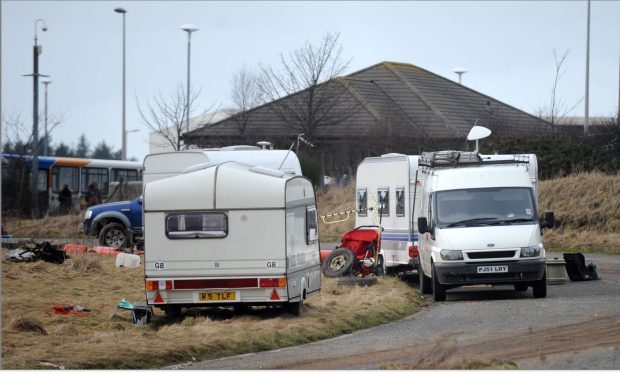Scottish government ministers have issued fresh guidance to local councils to put in place an early warning system to monitor illegal traveller sites across the north and north-east.
The radical move requires local authorities to keep watch over unauthorised encampments and report their movements to neighbouring regions.
It has also been suggested that councils “identify particular locations” which can officially be used for unapproved sites.
This follows the lead of North Esk Park, at St Cyrus, which was established without planning permission in 2013 and has since been retrospectively approved for travellers.
The new guidelines, which have been seen by the Press and Journal, are to be sent in a document to local authorities today instructing them on how to better handle the camps.
It also includes suggestions on how to deal with issues like recycling bins and portable toilets.
The Holyrood publication comes just a month after Aberdeenshire councillors approved controversial proposals to convert a disused quarry at Aikey Brae near Old Deer into the region’s first official encampment.
A report earlier in the year also revealed there were more illegal traveller camps in Aberdeenshire than anywhere else in Scotland last year, with 61 recorded.
The Scottish Government claims the revised guidance – which includes case studies on dealing with unauthorised sites – aims to balance the minority group’s rights to their traditional way of life with the need for responsibility for others.
The report, entitled ‘Guidance for local authorities on managing unauthorised camping by Gypsy/Travellers in Scotland’, reads: “Management of unauthorised sites should not be seen as purely a local issue, as Gypsy/Travellers will move across local authority boundaries as they travel.
“Local authorities should therefore consider ways to facilitate cross boundary co-operation.
“Such co-operation should look not only at sharing information but also at closer working on responses to unauthorised sites, particularly in areas that have traditional Gypsy/Traveller routes.
“This might involve partnership, working and sharing of local knowledge, expertise and costs associated with any new approaches to managing unauthorised sites.”
Aberdeen and neighbouring Aberdeenshire and Moray have often seen groups of travellers moving between the areas.
Last November Aberdeenshire Council agreed to set up a taskforce to tackle the region’s most “problematic” encampments.
In Moray, the Stewart family finally won a six-year fight last year after moving to an unauthorised site near Lhanbryde in 2010.
The family faced eviction by the council after a retrospective bid for the six caravans was rejected by the authority over fears they would become an eyesore.
But they were given a three-year reprieve by the Scottish Government on the grounds there was nowhere else for them to go.
Last year the Stewarts finally received permission to stay after council officials accepted the Doohill site met a shortfall of traveller sites in the region.
The report adds: “The Scottish Government recognises the right of Gypsy/Travellers to practice a nomadic lifestyle, including travelling and camping across Scotland.
“However, we also appreciate the local authorities have to balance this right with the needs of the settled community in their area.
“While the large majority of unauthorised sites do not cause any difficulties, some sites can give rise to friction…”
Local government minister Kevin Stewart said: “We are working toward a Scotland where the benefits of a multi-cultural country are recognised and celebrated – and Gypsy/Travellers are a valued part of our diverse society.
“Gypsy/Travellers have a right to their traditional way of life, but that right must be exercised responsibly and balanced against the rights of the wider community. This revised guidance supports that approach.”
Harry McGuigan, council body’s COSLA community wellbeing spokesperson, said: “Drawing on the knowledge and expertise within local authorities, and the views of Gypsy/Traveller communities, has strengthened this guidance and set out clear roles, rights and responsibilities for all those involved with unauthorised sites.”
